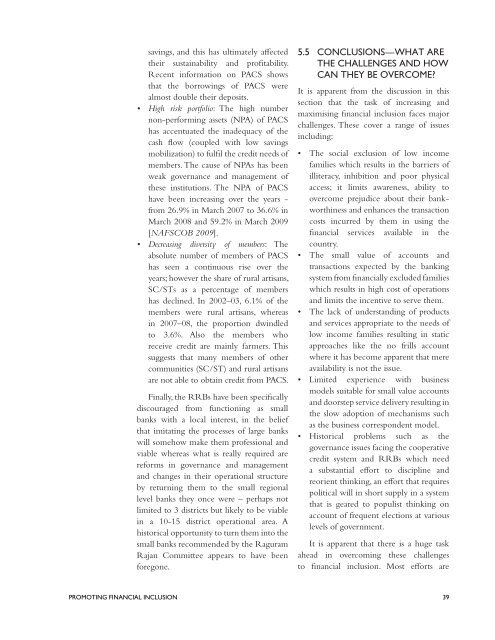Promoting Financial Inclusion - United Nations Development ...
Promoting Financial Inclusion - United Nations Development ...
Promoting Financial Inclusion - United Nations Development ...
You also want an ePaper? Increase the reach of your titles
YUMPU automatically turns print PDFs into web optimized ePapers that Google loves.
savings, and this has ultimately affected<br />
their sustainability and profitability.<br />
Recent information on PACS shows<br />
that the borrowings of PACS were<br />
almost double their deposits.<br />
• High risk portfolio: The high number<br />
non-performing assets (NPA) of PACS<br />
has accentuated the inadequacy of the<br />
cash flow (coupled with low savings<br />
mobilization) to fulfil the credit needs of<br />
members. The cause of NPAs has been<br />
weak governance and management of<br />
these institutions. The NPA of PACS<br />
have been increasing over the years -<br />
from 26.9% in March 2007 to 36.6% in<br />
March 2008 and 59.2% in March 2009<br />
[NAFSCOB 2009].<br />
• Decreasing diversity of members: The<br />
absolute number of members of PACS<br />
has seen a continuous rise over the<br />
years; however the share of rural artisans,<br />
SC/STs as a percentage of members<br />
has declined. In 2002–03, 6.1% of the<br />
members were rural artisans, whereas<br />
in 2007–08, the proportion dwindled<br />
to 3.6%. Also the members who<br />
receive credit are mainly farmers. This<br />
suggests that many members of other<br />
communities (SC/ST) and rural artisans<br />
are not able to obtain credit from PACS.<br />
Finally, the RRBs have been specifically<br />
discouraged from functioning as small<br />
banks with a local interest, in the belief<br />
that imitating the processes of large banks<br />
will somehow make them professional and<br />
viable whereas what is really required are<br />
reforms in governance and management<br />
and changes in their operational structure<br />
by returning them to the small regional<br />
level banks they once were – perhaps not<br />
limited to 3 districts but likely to be viable<br />
in a 10-15 district operational area. A<br />
historical opportunity to turn them into the<br />
small banks recommended by the Raguram<br />
Rajan Committee appears to have been<br />
foregone.<br />
5.5 CONCLUSIONS—WHAT ARE<br />
THE CHALLENGES AND HOW<br />
CAN THEY BE OVERCOME?<br />
It is apparent from the discussion in this<br />
section that the task of increasing and<br />
maximising financial inclusion faces major<br />
challenges. These cover a range of issues<br />
including:<br />
• The social exclusion of low income<br />
families which results in the barriers of<br />
illiteracy, inhibition and poor physical<br />
access; it limits awareness, ability to<br />
overcome prejudice about their bankworthiness<br />
and enhances the transaction<br />
costs incurred by them in using the<br />
financial services available in the<br />
country.<br />
• The small value of accounts and<br />
transactions expected by the banking<br />
system from financially excluded families<br />
which results in high cost of operations<br />
and limits the incentive to serve them.<br />
• The lack of understanding of products<br />
and services appropriate to the needs of<br />
low income families resulting in static<br />
approaches like the no frills account<br />
where it has become apparent that mere<br />
availability is not the issue.<br />
• Limited experience with business<br />
models suitable for small value accounts<br />
and doorstep service delivery resulting in<br />
the slow adoption of mechanisms such<br />
as the business correspondent model.<br />
• Historical problems such as the<br />
governance issues facing the cooperative<br />
credit system and RRBs which need<br />
a substantial effort to discipline and<br />
reorient thinking, an effort that requires<br />
political will in short supply in a system<br />
that is geared to populist thinking on<br />
account of frequent elections at various<br />
levels of government.<br />
It is apparent that there is a huge task<br />
ahead in overcoming these challenges<br />
to financial inclusion. Most efforts are<br />
PROMOTING FINANCIAL INCLUSION 39

















